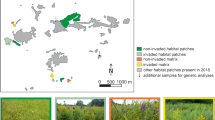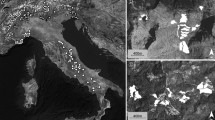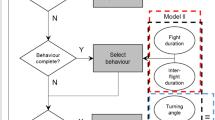Abstract
Relations between species mobility and life history traits and/or landscape and habitat features are of broad interest to ecologists and conservation biologists. Here we investigated the reliability of the relations between mobility and (1) resource grain and (2) morphological traits in butterflies. Results were used to assess the biological realism of morphological traits associated with flight as mobility proxies. We then investigated how biological, environmental and landscape variables affected these mobility proxies. We used a multi-species approach on two different sites. Morphological traits were measured on ca. 20 individuals per site, species and sex. Resource distribution was carefully monitored by investigating the spatial distribution and overlap of larval and adult feeding resources, together representing the resource grain. The spatial extent of individual station keeping movements was estimated from distances recorded between successive recaptures of individuals from mark-release-recapture experiments. Morphological traits seemed reliable proxies of mobility, as both variables were strongly correlated. Morphological variations were related to flight type and spatial dimension of nectar resource. The most striking point was the clear relation between the index of relative investment in mobility versus fecundity in females with the spatial dimension of adult feeding resource. Given the generally accepted relation between abdomen volume and female fecundity, this suggests that females might invest more in fecundity when nectar resources are widespread. Finally, we did not detected effects of landscape structure on mobility, which indicates that functional grain of resources is more likely to influence mobility and evolution of morphology in butterflies than landscape connectivity.



Similar content being viewed by others
References
Anderson DR (2008) Model based inference in the life sciences: a primer on evidence. Springer, New York
Baguette M (2003) Long distance dispersal and landscape occupancy in a metapopulation of the cranberry fritillary butterfly. Ecography 26:153–160
Baguette M, Mennechez G (2004) Resource and habitat patches, landscape ecology and metapopulation biology: a consensual viewpoint. Oikos 106:399–403
Baguette M, Nève G (1994) Adult movements between populations in the specialist butterfly Proclossiana eunomia (Lepidoptera, Nymphalidae). Ecol Entomol 19:1–5
Baguette M, Schtickzelle N (2003) Local population dynamics are important to the conservation of metapopulations in highly fragmented landscapes. J Appl Ecol 40:404–412
Baguette M, Van Dyck H (2007) Landscape connectivity and animal behavior: functional grain as a key determinant for dispersal. Landscape Ecol 22:1117–1129
Bell WJ (1991) Searching behaviour. The behavioural ecology of finding resources. Chapman and Hall, London
Benard MF, McCauley SJ (2008) Integrating across life-history stages: consequences of natal habitat effects on dispersal. Am Nat 171:553–567
Berwaerts K, Aerts P, Van Dyck H (2006) On the sex-specific mechanisms of butterfly flight: flight performance relative to flight morphology, wing kinematics, and sex in Pararge aegeria. Biol J Linn Soc 89:675–687
Betts CR, Wootton RJ (1988) Wing shape and flight behaviour in butterflies (Lepidoptera Papilionidae and Hesperioidiae): a preliminary analysis. J Exp Biol 138:271–288
Blondel J, Thomas DW, Charmantier A et al (2006) A thirty-year study of phenotypic and genetic variation of Blue Tits in mediterranean habitat mosaics. Bioscience 56:661–673
Bowne DR, Bowers MA (2004) Interpatch movements in spatially structured populations: a literature review. Landscape Ecol 19:1–20
Brommer JE, Fred MS (2001) Movement of the Apollo butterfly Parnassius apollo related to host plant and nectar plant patches. Ecol Entomol 24:125–131
Burnham KP, Anderson DR (2002) Model selection and multimodel inference: a practical information-theoretic approach. Springer, New York
Cook LM, Dennis RLH, Hardy PB (2001) Butterfly-hostplant fidelity, vagrancy and measuring mobility from distribution maps. Ecography 24:497–504
Dempster JP (1991) Fragmentation, isolation and mobility of insect populations. In: Collins NM, Thomas JA (eds) The conservation of insects and their habitats. Academic Press, London, pp 143–153
Dempster JP, King ML, Lakhani KH (1976) The status of the swallowtail butterfly in Britain. Ecol Entomol 1:71–84
Dennis RLH, Shreeve TG, Van Dyck H (2003) Towards a functional resource-based concept for habitat: a butterfly biology viewpoint. Oikos 102:417–426
Dennis RLH, Shreeve TG, Arnold HR et al (2005) Does diet breadth control herbivorous insect distribution size? Life history and resource outlets for specialist butterflies. J Insect Conserv 9:187–200
Dingle H (1996) Migration. The biology of life on the move. Oxford University Press, New York
Dudley R (1991) Biomechanics of flight in Neotropical butterflies: aerodynamics and mechanical power requirements. J Exp Biol 150:335–357
Edwards JW, Heckel DG, Guynn DC (1998) Niche overlap in sympatric populations of fox and gray squirrels. J Wildl Manage 62:354–363
Guisan A, Thuiller W (2005) Predicting species distribution: offering more than simple habitat models. Ecol Lett 8:993–1009
Hanski I, Saastamoinen M, Ovaskainen O (2006) Dispersal-related life-history trade-offs in a butterfly metapopulation. J Anim Ecol 75:91–100
Heino M, Hanski I (2001) Evolution of migration rate in a spatially realistic metapopulation model. Am Nat 157:495–511
Hill JK, Thomas CD, Lewis OT (1999) Flight morphology in fragmented populations of a rare British butterfly, Hesperia comma. Biol Conserv 87:277–283
Hirzel AH, Le Lay G (2008) Habitat suitability modelling and niche theory. J Appl Ecol 45:1372–1381
Hovestadt T, Nowicki P (2008) Investigating movement within irregularly shaped patches: analysis of mark-release-recapture data using randomization procedures. Isr J Ecol Evol 54:131–154
Johnson CG (1969) Migration and dispersal by flight. Methuen, London
Jones RE (1977) Movements patterns and egg distribution in cabbage butterflies. J Anim Ecol 46:195–212
Lenoir J, Gégout JC, de Ruffay PA et al (2008) A significant upward shift in plant species optimum elevation during the 20th century. Science 320:1768–1771
Linton LR, Davies RW, Wrona FJ (1981) Resource utilization indices: an assessment. J Anim Ecol 50:283–292
Murphy DD, Menninger MS, Ehrlich PR (1984) Nectar source distribution as a determinant of oviposition host species in Euphydryas chalcedona. Oecologia 62:269–271
Nathan R, Getz WM, Revilla E et al (2008) A movement ecology paradigm for unifying organismal movement research. Proc Natl Acad Sci 105:19052–19059
Norberg U, Leimar O (2002) Spatial and temporal variation in flight morphology in the butterfly Melitaea cinxia (Lepidoptera: Nymphalidae). Biol J Linn Soc 77:445–453
Peixoto PEC, Benson WW (2008) Body mass and not wing length predicts territorial success in a tropical Satyrine butterfly. Ethology 114:1069–1077
Pfeifer MA, Henle K, Settele J (2007) Populations with explicit borders in space and time: concept, terminology, and estimation of characteristic parameters. Acta Biotheor 55:305–316
Pollard E, Yates TJ (1993) Monitoring butterflies for ecology and conservation. Chapman & Hall, London
Revilla E, Wiegand T, Palomares F et al (2004) Effects of the matrix heterogeneity on animal dispersal: from individual behavior to metapopulation-level parameters. Am Nat 164:E130–E153
Roff DA, Fairbairn D (2001) The genetic basis of dispersal and migration, and its consequences for evolution of correlated traits. In: Clobert J, Danchin E, Dhondt AA, Nichols JD (eds) Dispersal. Oxford University Press, Oxford, pp 191–202
Romero S, Campbell JF, Nechols JR et al (2009) Movement behavior in response to landscape structure: the role of functional grain. Landscape Ecol 24:39–51
Ronce O (2007) How does it feel to be like a rolling stone? Ten questions about dispersal evolution. Annu Rev Ecol Evol Syst 38:231–253
Ruckelshaus M, Hartway C, Kareiva P (1999) Dispersal and landscape errors in spatially explicit population models: a reply. Conserv Biol 13:1223–1224
Schtickzelle N, WallisDeVries MF, Baguette M (2005) Using surrogate data in population viability analysis: the case of the critically endangered cranberry fritillary butterfly. Oikos 109:89–100
Schtickzelle N, Mennechez G, Baguette M (2006) Dispersal depression with habitat fragmentation in the bog fritillary butterfly. Ecology 87:1057–1065
Schultz CB, Dlugosch KM (1999) Nectar and hostplant scarcity limit populations of an endangered Oregon butterfly. Oecologia 119:231–238
Singer MC, Thomas CD (1996) Evolutionary responses of a butterfly metapopulation to human- and climate-caused environmental variation. Am Nat 148:S9–S39
Singer MC, Thomas CD, Parmesan C (1993) Rapid human-induced evolution of insect–host associations. Nature 366:681–693
Southwood TRE (1977) Habitat, the templet for ecological strategies? J Anim Ecol 46:365–377
Stanton ML (1982) Searching in a patchy environment: foodplant selection by Colias P. eriphyle butterflies. Ecology 63:839–853
Thomas CD, Hill JK, Lewis OT (1998) Evolutionary consequences of habitat fragmentation in a localized butterfly. J Anim Ecol 67:485–497
Thomas CD, Cameron A, Green RE et al (2004) Extinction risk from climate change. Nature 427:145–148
Thuiller W, Albert C, Araujo MB et al (2008) Predicting global change impacts on plant species’ distributions: future challenges. Perspect Plant Ecol Evol Syst 9:137–152
Turlure C, Van Dyck H (2009) On the consequences of aggressive male mate locating behaviour and microclimate for female host plant use in the butterfly Lycaena hippothoe. Behav Ecol Sociobiol 63:1581–1591
Turlure C, Van Dyck H, Schtickzelle N et al (2009) Resource-based definition of the habitat, niche overlap and conservation of two glacial relict butterflies. Oikos 118:950–960
Van Dyck H, Baguette M (2005) Dispersal behaviour in fragmented landscapes: routine or special movements? Basic Appl Ecol 6:535–545
Van Dyck H, Matthysen E (1999) Habitat fragmentation and insect flight: a changing ‘design’ in a changing landscape? Trends Ecol Evol 14:172–174
Wickman PO (1992) Sexual selection and butterfly design—a comparative study. Evolution 46:1525–1536
Wiklund C, Ahrberg C (1978) Host plants, nectar source plants, and habitat selection of males and females of Anthocharis cardamines (Lepidoptera). Oikos 31:169–183
Wilson RJ, Gutierrez D, Gutierrez J et al (2007) An elevational shift in butterfly species richness and composition accompanying recent climate change. Glob Chang Biol 13:1873–1887
Zera AJ, Denno RF (1997) Physiology and ecology of dispersal polymorphism in insects. Annu Rev Entomol 42:207–230
Acknowledgments
We thank Julie Choutt and Amélie Augem for their valuable help with field work and Hans Van Dyck and two anonymous reviewers for helpful comments on the first version of this manuscript. C.T. was supported by a Ph.D. grant of the FRIA-fund. N.S. is Research Associate of the Fund for Scientific Research-FNRS. Site access and permission to study the species in the field were granted by the Ministère de la Région Wallonne. This is publication BRC145 of the Biodiversity Research Centre at UCL.
Author information
Authors and Affiliations
Corresponding author
Rights and permissions
About this article
Cite this article
Turlure, C., Schtickzelle, N. & Baguette, M. Resource grain scales mobility and adult morphology in butterflies. Landscape Ecol 25, 95–108 (2010). https://doi.org/10.1007/s10980-009-9403-3
Received:
Accepted:
Published:
Issue Date:
DOI: https://doi.org/10.1007/s10980-009-9403-3




